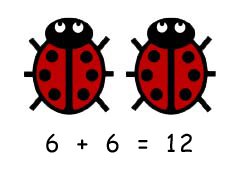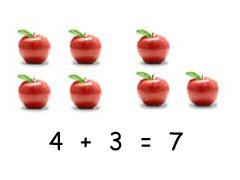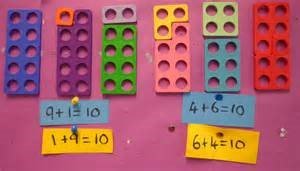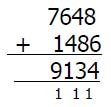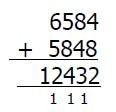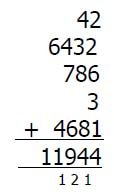
Addition Stages
Stage 1: Pictures and Objects
Children are encouraged to develop a mental picture of the number system in their heads to use for calculation. They develop ways of recording calculations using pictures, real life objects, mark making and a variety of practical resources.
|
|
|
|
Numicon is used extensively to provide a strong visual image to support addition sentences.
|
|
|
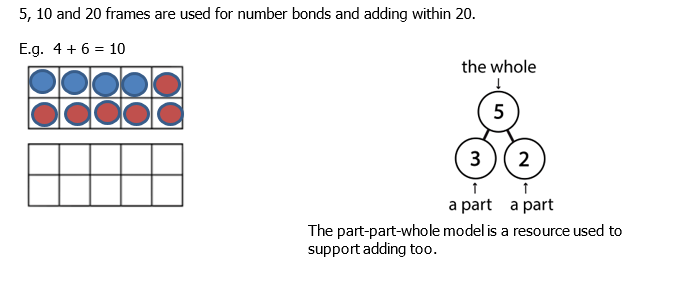
Stage 2: The Number Line
Children use number lines and practical resources to support calculation and teachers demonstrate the use of the number line. The use of the number line is seen as an intermediate step before more formal recording methods are taught.

Children then begin to use numbered lines to support their own calculations using a numbered line to count on in ones, then in other multiples e.g. 5’s and 10’s.

Bead strings provide a useful practical visual image to mirror the jumps on the number line. 10 + 2 = 12

Stage 3: The Empty Number Line
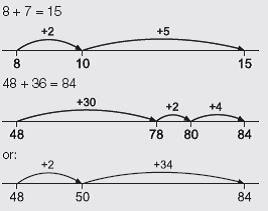 This should be a secure method for most children as part of informal jottings for mental calculations. It is crucial that children have reliable “jottings” strategies which link the concrete representation that resources provide to a pictoral or mental method. Written, informal jottings must be taught alongside the use of resources to enable this strategy to develop.
This should be a secure method for most children as part of informal jottings for mental calculations. It is crucial that children have reliable “jottings” strategies which link the concrete representation that resources provide to a pictoral or mental method. Written, informal jottings must be taught alongside the use of resources to enable this strategy to develop.
Steps in addition can be recorded on a number line. The steps often bridge through a multiple of 10.
Stage 4: Supported Column Method
This method will be taught as an introduction to a columnar method for recording addition from Year 2 onwards although children will become more familiar with the vertical layout in Year 3. The use of resources (Dienes base 10 apparatus and place value mats) are crucial to support this method. A sound knowledge of place value is necessary at this stage. The development of this more formal columnar method begins by encouraging the representation of TU numbers in a variety of ways, e.g as pictoral representations.
The formal recording with the columnar layout mirrors the practical use of the Dienes apparatus and is recorded alongside the practical procedure.
Vocabulary:
“start with the units”, "regroup"
Example without regrouping:
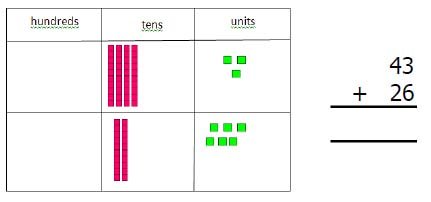 Step 1:
Step 1:
Dienes apparatus is used to represent both numbers in the calculation, set out on the place value mat in the correct columns.
 Step 2:
Step 2:
“Starting with the units”, the digit representations in each place value column are combined upwards to form a total.
The resulting totals of “units” and “tens” are written simultaneously in the column layout to reinforce what is happening.
Example using regrouping:
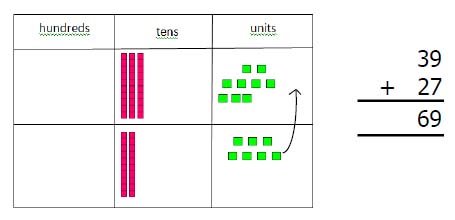 Step 1:
Step 1:
Dienes apparatus is again used to represent both numbers in the calculation, set out on the place value mat in the correct columns.
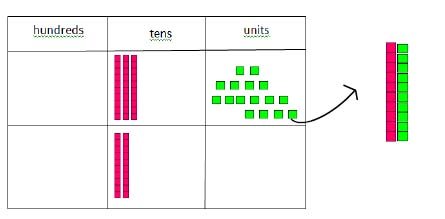 Step 2:
Step 2:
“Starting with the units”, the digit representations in each place value column are combined upwards to form a total.
Combining the units gives us too many for the units column, “we can’t have more than nine in the units”.
Ten of the units cubes must be regrouped into a ten stick.
 Step 3:
Step 3:
This leaves six cubes in the units column to be recorded in the written method. The one regrouped ten stick is now placed underneath the tens column; this is mirrored in the recording of the one ten under the line in the written calculation.
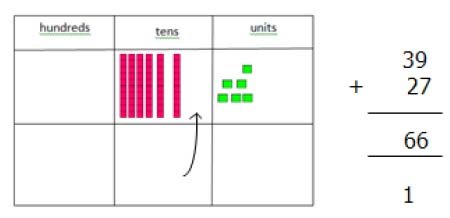 Step 4:
Step 4:
Finally, the tens are combined upwards (including the regrouped ten) to give a resulting total of tens which is recorded in the written calculation.
Stage 4 extended: jottings
Once children are familiar with using dienes apparatus, they should quickly move to recording their workings using jottings. This gives children the ability to find the answer without using apparatus bridging the link between concrete and abstract representations. This method is shown below:
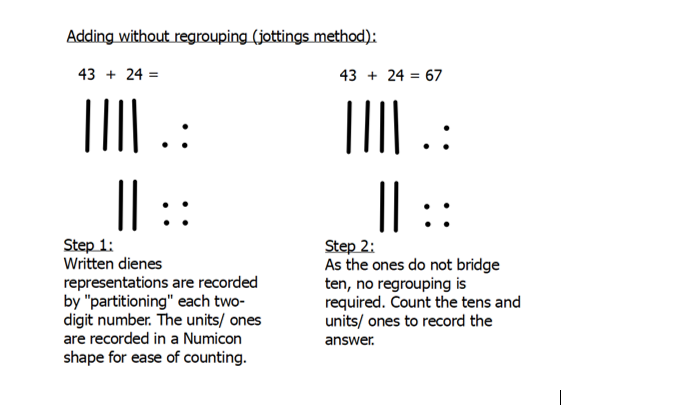
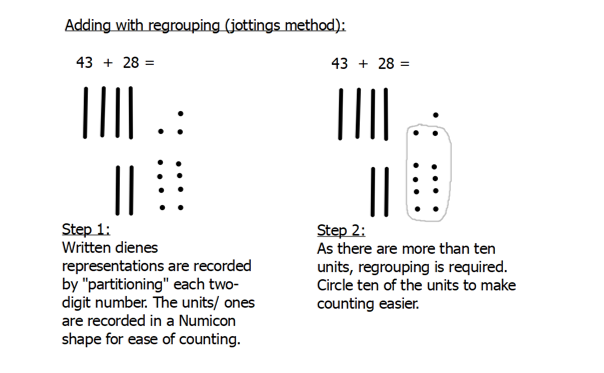
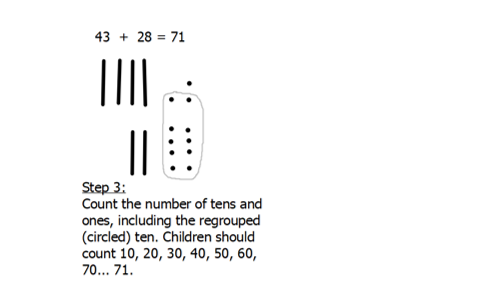
Please note the same vocabulary “start with the units/ones”, “partition” and “regroup” applies for the jottings method. Also the jottings are always recording underneath each other which supports preparation for the column method.
When approaching word problems, the bar model provides a strong visual representation to support addition in the context of real world problems. Each number within the problem is represented by a bar, showing the unknown total as a blank bar. This is also reinforced through the use of Cuisenaire rods to mirror the bar model. Jottings can then be made to support finding the total.
|
|
|
Stage 5: Column Method
Most children should be secure in this method by the end of Year 4. Through use of the apparatus and supported column method procedure, children will become confident to record just the written calculation in column format. Earlier use of concrete apparatus reinforces the understanding of where the regrouped ten or hundred have originated from.
|
|
|
|
By the end of year 5 children should extend this method to addition of any number of digits.
|
|
|
|
Column addition remains efficient when used with larger whole numbers and decimals. Once learned, the method is quick and reliable.
- Rectory Gardens, Worthing
West Sussex, BN14 7TQ - OFFICE@BROADWATERCE.ORG
- 01903 235389



